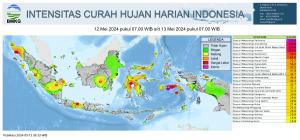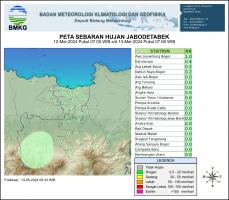Is Indonesia tracked by tropical cyclone?
According to the climatology, Indonesia that lies on the equator is not tracked by tropical cyclone. Yet there are enough cyclones occurred around to change weather pattern over the area. For example, Cyclone Rossie (2008) which passed west of Banten, Kirrily (2009) that developed above Aru Islands, Inigo which passed Nusa Tenggara at its developing stage, and Vamei (2001), claimed as the closest to equator cyclone when it developed around Malaka Peninsula at 1.5°N.

Using tropical cyclone data for a period from 1964 to 2005 for South East Indian Ocean basin and from 1951 to 2006 for Western North Pasific basin, calculation has been carried out to describe cyclone occurance at area of near Indonesia especially from 90o to 150o E and from 30° S to 30° N.
South of Indonesia Cyclone
From historical data over a period of 42 years, it is known that majority of cyclone occurance at south of Indonesia is on February at 23%. It is 122 cyclones occurred, that means about three cyclones in average. On this month, the most peak year is in 1968 when 7 cyclones developed in this area. Though there were February 1867, 1990 and 2002 when there was no cyclone developed.
While December, as the second peak month of the period, there were 76 cyclones occurred, that means about 2 cyclones in average. Extreme event was experienced at December 1973 when 6 cyclones developed in a month.
However, almost no cyclone occurred on June and August.

North of Indonesia Cyclone
With longer historical data for 56 years, it is calculated that the most peak month at the area is August with 20% cyclone occurance, followed with September (18%), July and October (15%).
In august, when about 5 cyclones occurrence in average, maximum number of cyclone was experienced in 1960 when 13 cyclones occurred and minimum in 1980 when only 2 cyclones occurred. Contrarily, in February with the least cyclone occurance (only 13 cyclone in 56 years), 1967 and 1976 experience 2 cyclones, 9 other years with one cyclone, and 45 others none.
In August, the most peak month in this area, 107 from 323 cyclones are intensified to gained storm force wind, and 81 from those are developed to gained hurricane force wind.

Table of Contents
« Tropical Cyclone, Tropical Storm, Hurricane & Typhoon
Cyclone Impact »
Each cyclone is named. In Atlantic Ocean or in Australia region, cyclone name is adopted from human name. Though in Pasific Ocean, cyclone name is more variable such as Cyclone Anggrek (orchid in Indonesia language), Durian (a very rich flavoured fruit), Nuri (BLUE crowned parroquet in the Malay language), Halong (a beautiful bay in Vietnam), Mekhala (angel of thunder), Bavi (a mountain chain in northern Viet Nam), and Fengshen (God of wind).
Table of Contents
« Cyclone Impact
Tropical Cyclone Warning Centre (TCWC) »
Global Guide to Tropical Cyclone Forecasting. http://www.cawcr.gov.au/bmrc/pubs/tcguide/globa_guide_intro.htm
Khotimah, M.K. Siklon Dekat Ekuator.
Khotimah, M.K., 2008. Klimatologi Siklon Tropis Di Sekitar Indonesia. Buletin Meteorologi dan Geofisika.
Khotimah, M.K., A. F. Radjab, M. Budiarti. 2009. Siklon Tropis Kirrily: Anomali di Dekat Ekuator. Buletin Meteorologi dan Geofisika. April 2009.
Laporan Kegiatan Tropical Cyclone Warning Centre (TCWC) Jakarta 2007.
Laporan Tahunan 2008 Jakarta Tropical Cyclone Warning Center BMKG.
Operational Directive Tropical Cyclone Warning Centre (TCWC) Jakarta 2010. V.1.0 Januari 2010.
Tropical Cyclone Records Central Pasific Hurricane Center, National Weather Service http://www.prh.noaa.gov/cphc/pages/FAQ/Tropical_Cyclone_Records.php
WMO. Technical Document WMO/TD-No.292 Tropical Cyclone Programme Report No. TCP-24 Tropical Cyclone Operational Plan For The South Pasific and South-East Indian Ocean 2008 edition.
Table of Contents
« Jakarta TCWC
The main goal of a Tropical Cyclone Warning Centre is to minimalize loss of life and property and other impacts of tropical cyclone occurrence by providing accurately and timely warning to the threatened community.
A tropical cyclone warning system at least involving four parties :
- Meteorological agency, that provide the warnings
- Mass media, that broadcast the warnings
- Disaster management institution, at national and regional level
- Threatened community
There are Tropical Cyclone Warning Centres all over the world to monitor every occurrence of tropical cyclone. Everywhere, this monitoring is continuously performed everyday for 24 hours by using various kind of technology, from satellite, radar, and manned or unmanned observation stations. It purposes are to monitor the development of cyclone, it movement and intensity.
Tropical Cyclone Warning Centre is also responsible to provide tropical cyclone related warning and information and dissiminate them to the threatened area.
Basically there are two kinds of tropical cyclone warning, i.e. Coastal Waters and Land Area Warning and Warning for Open Sea. Each member of Regional Bodies is responsible to produce Warning for their coastal waters and land area. Though Warning for Open Sea is made by the concerned Tropical Cyclone Warning Centre according to their Area of Responsibility.
Table. WMO Regional Bodies, Committee and their Area of Responsibility
Table of Contents
« Cyclone Name
Jakarta TCWC »
-
Tropical Cyclone Warning Centre (TCWC)
-
History of Jakarta TCWC
-
What is cyclone
-
Cyclogenesis
-
Cyclone Life Cycle
-
Differences Between Cyclone, Tornado, Puting Beliung & Water Spout
-
Tropical Cyclone, Tropical Storm, Hurricane & Typhoon
-
Near Indonesia Cyclone Season
-
Cyclone Impact
-
Cyclone Name
-
Reference













